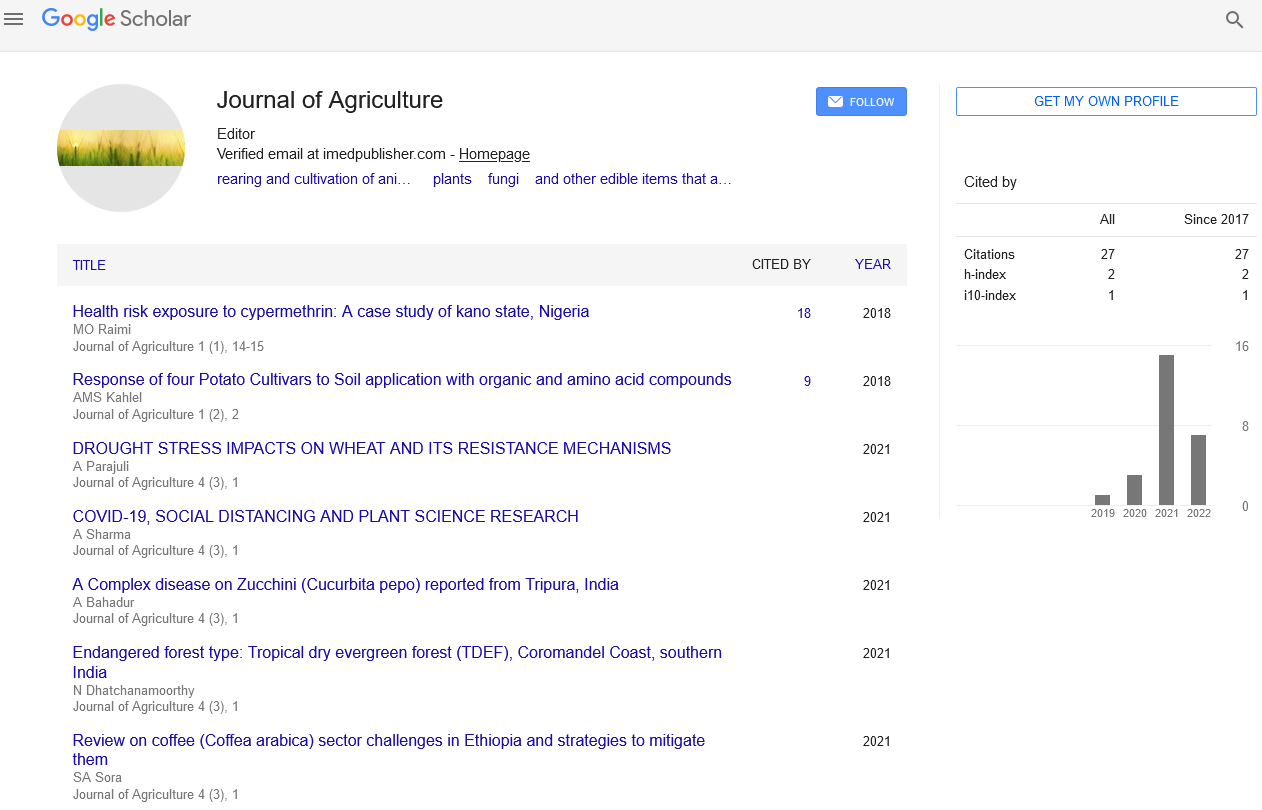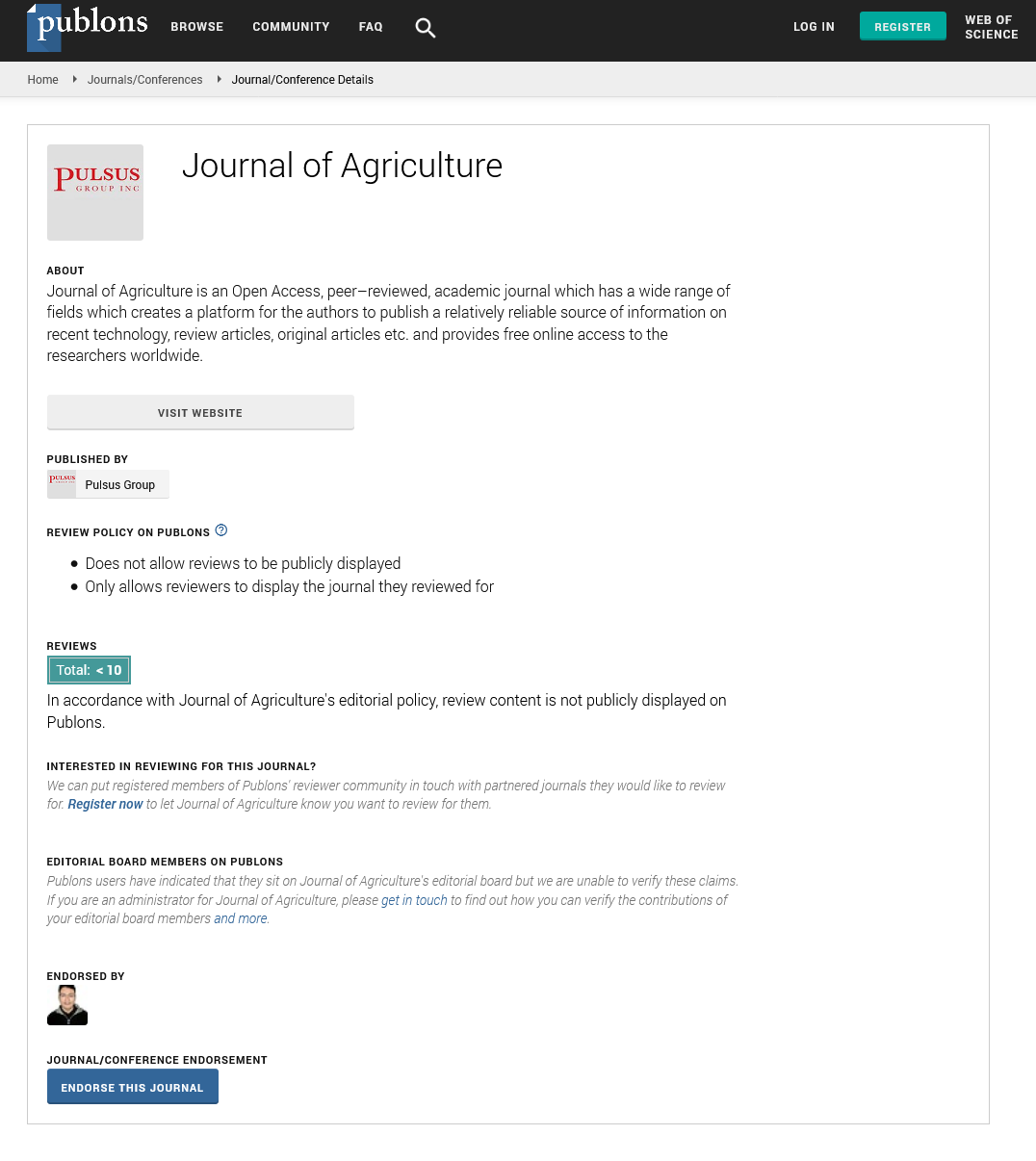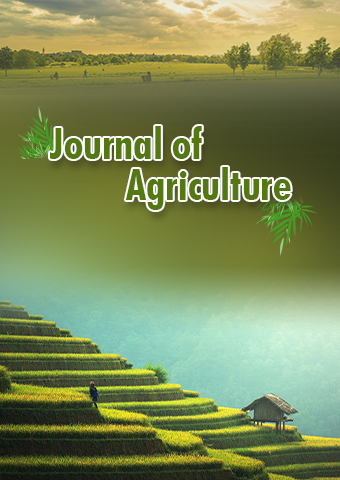Mini Review - Journal of Agriculture (2023) Volume 6, Issue 3
The Power of Agricultural Technology to Revolutionise Agriculture
Supshing Meher*
Department of Economics and Management, Panzhihua University, China
Department of Economics and Management, Panzhihua University, China
E-mail: supshing34@gmail.com
Received: 31-May-2023, Manuscript No. jagri-23-103204; Editor assigned: 02-Jun-2023, Pre-QC No. jagri-23-103204 (PQ); Reviewed: 16- Jun-2023, QC No. jagri-23-103204; Revised: 21-Jun-2023, Manuscript No. jagri-23-103204 (R); Published: 28-Jun-2023, DOI: 10.37532/ jagri.2023.6(3).76-78
Abstract
the global agricultural sector. The rapid advancements in technology have revolutionized various aspects of agriculture, including crop cultivation, livestock management, pest control, and farm productivity. This abstract explores the impact of agricultural technology on the industry, highlighting its potential benefits, challenges, and future prospects. The integration of cutting-edge technologies such as precision agriculture, robotics, biotechnology, and remote sensing has significantly enhanced the efficiency and sustainability of agricultural practices. Precision agriculture, enabled by the use of sensors, drones, and GPS technology, allows farmers to optimize inputs like water, fertilizers, and pesticides, resulting in higher yields, reduced costs, and minimized environmental impact. Robotics and automation have automated labor-intensive tasks, improving productivity and reducing human error. Biotechnology has revolutionized crop breeding and genetic modification, leading to the development of genetically engineered crops with enhanced traits such as resistance to pests, diseases, and adverse environmental conditions. These advancements have the potential to address food security challenges and reduce the reliance on chemical inputs, thereby promoting sustainable agriculture practices. The use of remote sensing technologies, including satellites and drones, enables real-time monitoring of crops, soil moisture, and weather conditions. This data-driven approach allows farmers to make informed decisions about irrigation, fertilization, and disease management, optimizing resource allocation and minimizing waste. While agricultural technology offers tremendous opportunities, it also presents challenges that need to be addressed. These include the high initial investment costs, access to technology for small-scale farmers, data ownership and privacy concerns, and potential social and ethical implications of genetic engineering. Looking ahead, the future of agricultural technology holds immense promise. Advancements in artificial intelligence and machine learning are expected to further enhance decision-making capabilities, enabling predictive analytics and customized farm management. Additionally, the integration of block chain technology may promote transparency and traceability in the agricultural supply chain, ensuring food safety and quality Agricultural technology has ushered in a new era of innovation and productivity in the agricultural sector. The integration of advanced technologies has the potential to revolutionize farming practices, improve resource efficiency, mitigate environmental impacts, and address global food security challenges. However, it is essential to address the challenges associated with technology adoption and ensure equitable access to its benefits. Future research and collaborations are necessary to unleash the full potential of agricultural technology and create a sustainable and resilient agricultural system for the future.
Keywords
Agricultural technology • Crop cultivation • Livestock • Pest control • Genetic modification • Fertilizers • Robotics • Crop breeding
Introduction
Agriculture has been the backbone of human civilization since its inception, providing sustenance and livelihoods for countless communities around the world. In recent decades, the field of agriculture has undergone a remarkable transformation through the integration of advanced technologies. Agricultural technology, also known as agri-tech or ag-tech, encompasses a range of innovative solutions that have revolutionized farming practices, increased productivity, and paved the way for sustainable food production [1]. This article explores the remarkable advancements in agricultural technology and their impact on modern farming.
Enhancing efficiency and yield
Precision farming is one of the key breakthroughs in agricultural technology, enabling farmers to optimize their resources and maximize yields while minimizing environmental impact. It involves the use of global positioning systems (GPS), remote sensing, and data analytics to assess and manage variations in soil conditions, crop growth, and pest infestations [2]. Farmers can precisely determine the ideal time for planting, fertilizing, and harvesting, leading to increased efficiency and reduced costs.
Drones and satellites: monitoring and crop management
Unmanned aerial vehicles (UAVs), commonly known as drones, equipped with highresolution cameras and sensors, are transforming the way farmers monitor and manage their crops. Drones can efficiently survey large agricultural areas, capturing detailed images and data on crop health, soil moisture levels, and weed infestations. This real-time information helps farmers identify issues early on, enabling targeted interventions such as precision spraying of pesticides and efficient irrigation systems [3]. Satellites are also being used to collect valuable data on weather patterns, soil quality, and vegetation indices, providing farmers with a broader perspective on their farming operations.
Internet of things (IOT): connecting farms for smart agriculture
The Internet of Things (IoT) has found its way into agriculture, connecting sensors, devices, and machinery to create a networked agricultural ecosystem. IoT-enabled systems can collect data on soil moisture, temperature, humidity, and even livestock health, transmitting this information to farmers’ smartphones or computers. By analysing real-time data, farmers can make informed decisions, adjust irrigation schedules, and automate various processes [4]. IoT also plays a vital role in livestock management, enabling farmers to remotely monitor animal health, feeding patterns, and environmental conditions in real-time.
Vertical farming and indoor agriculture: cultivating in limited spaces
The growing demand for food, coupled with limited arable land, has spurred the development of vertical farming and indoor agriculture systems. These innovative techniques involve growing crops in vertically stacked layers or in controlled environments, using artificial lighting, hydroponics, and advanced climate control systems. Vertical farming optimizes land usage, reduces water consumption, eliminates the need for harmful pesticides, and enables year-round production of high-quality, locally grown produce. These systems are particularly valuable in urban areas where access to fresh, locally sourced food is limited [5,6].
Biotechnology and genetic engineering: improving crop traits
Biotechnology and genetic engineering have transformed crop breeding and development, leading to the creation of genetically modified organisms (GMOs) with enhanced traits [7]. Scientists can modify plant DNA to confer resistance to pests, diseases, and environmental stressors, resulting in higher crop yields and reduced reliance on chemical inputs [ 8]. Biotechnology also enables the production of crops with improved nutritional profiles, such as bio fortified varieties that address specific nutrient deficiencies prevalent in certain regions. However, GMOs remain a subject of debate due to concerns related to environmental impact and consumer acceptance [9,10].
Conclusion
Agricultural technology continues to push the boundaries of what is possible in modern farming. From precision farming and drone technology to IoT connectivity and genetic engineering, these advancements have the potential to address key challenges faced by the agricultural sector. They enhance productivity, promote sustainability, and contribute to food security in a rapidly changing world.
References
- Kedes DH, Operskalski E, Busch M et al. The seroepidemiology of human herpesvirus 8 (Kaposi's sarcoma-associated herpesvirus): distribution of infection in KS risk groups and evidence for sexual transmission. Nat Med 2, 918-924 (1996).
- Johnson KJ, Carozza SE, Chow EJ et al. Parental age and risk of childhood cancer: a pooled analysis. Epidemiology. 20, 475-483 (2009).
- Smith JG, Christophers AJ. Phenoxy herbicides and chlorophenols: a case control study on soft tissue sarcoma and malignant lymphoma. Br J Cancer. 65, 442-448 (1992).
- Pukkala E. Occupation and cancer - follow-up of 15 million people in five Nordic countries. Acta Oncol. 48, 646-790 (2009).
- Schwartz SE, Levine RA, Weinstock RS et al. Sustained pectin ingestion: effect on gastric emptying and glucose tolerance in non-insulin-dependent diabetic patients. Am J Clin Nutr. 48, 1413-7 (1988).
- Booth FW, Chakravarthy MV. Physical activity and dietary intervention for chronic diseases: a quick fix after all. J Appl Physiol. 100, 1439-40 (2006).
- Anderson JW, Ward K. High-carbohydrate, high-fiber diets for insulin-treated men with diabetes mellitus. Am J Clin Nutr. 32, 2312-21 (1979).
- Beccuti G, Monagheddu C, Evangelista A et al.Timing of food intake: Sounding the alarm about metabolic impairments? A systematic review. Pharmacological Research. 125, 132–141 (2017).
- Dian Dhika A, Nasution U. Effect Of Extraction Method Of Tithonia Diversifolia Leaves Against Spodoptera Frugiperda Larva Mortality. J Pharm Life Sci. 8(10), 22-25 (2022).
- Hu Y, Qin F, Huang L et al. Rice histone deacetylase genes display specific expression patterns and developmental functions.Biochemical and biophysical research communications.388, 266-271(2009).
Indexed at, Crossref, Google Scholar
Indexed at, Crossref, Google Scholar
Indexed at, Crossref, Google Scholar
Indexed at, Crossref, Google Scholar
Indexed at, Google Scholar, Crossref
Indexed at, Google Scholar, Crossref
Indexed at, Google Scholar, Crossref
Indexed at, Google Scholar, Crossref


